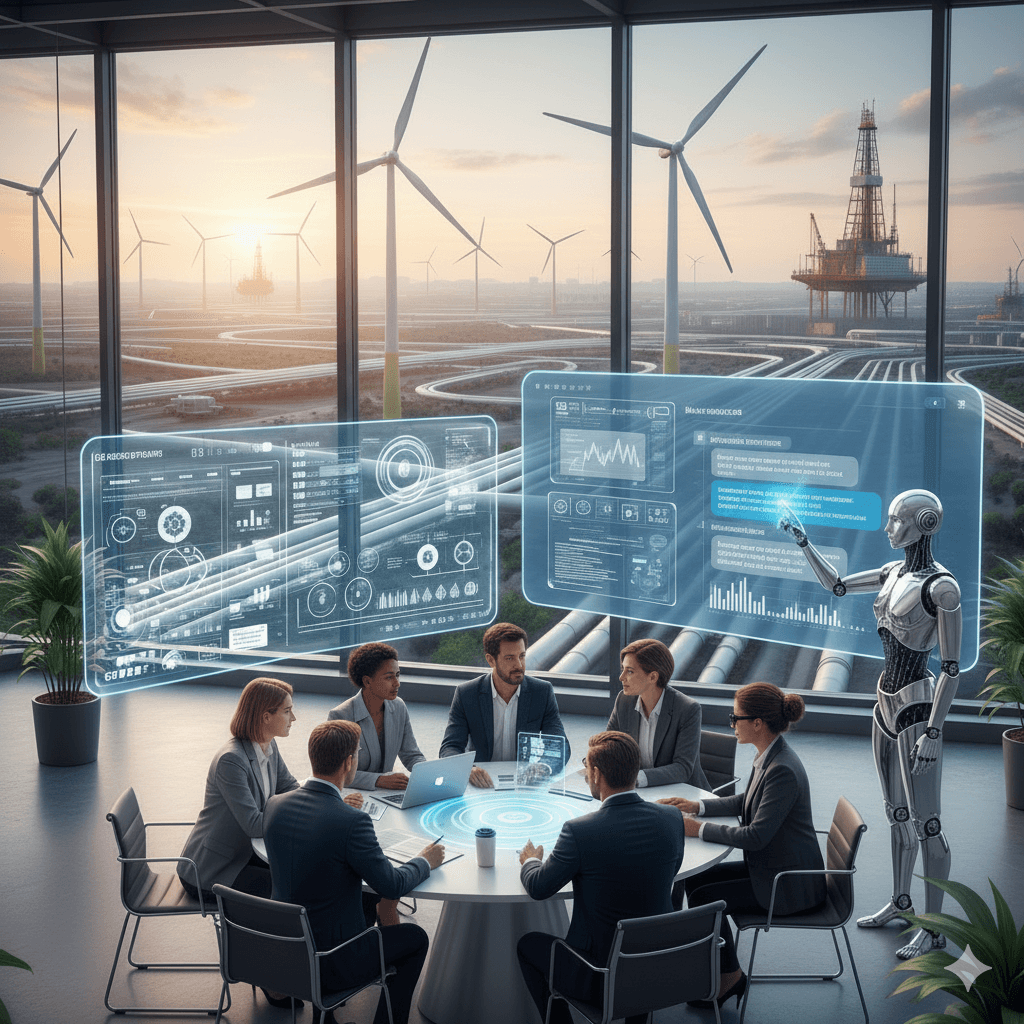1. The AI Paradox
MIT’s 2025 State of AI in Business report revealed a striking fact: 95% of corporate AI projects fail to deliver measurable results. Not because the models are bad — but because companies deploy AI without preparing the humans meant to use it.
Across industries, organizations are investing billions in AI tools — ChatGPT Enterprise, Copilot, internal copilots, AI-powered dashboards. But the ROI is flat. MIT calls this phenomenon the “GenAI Divide” — a gap between companies that turn AI into results and the many that stay trapped in endless pilots.
And the Energy industry? It ranks at the very bottom. The report found “near-zero adoption and minimal experimentation” in Energy and Materials — not due to lack of potential, but because most companies never connected AI tools to their real workflows or trained staff to use them effectively.
If the technology works, why don’t the results show?
The answer: the problem isn’t the AI. It’s the humans — and the lack of proper onboarding.
2. When We Gave Employees Laptops, We Trained Them
When computers arrived in offices, we didn’t just drop them on desks. We trained people to use them. When Excel, ERP systems, and email came along, companies invested heavily in onboarding and SOP integration.
Yet today, employees are handed access to ChatGPT or Copilot with no setup, no guidance, no adaptation to their roles.
From the training sessions I’ve led in the energy and EPC sectors, not a single engineer, buyer, or drafter had a proper ChatGPT or Copilot setup. No custom instructions. No defined workflows. No Prompt Library. No understanding of how to turn AI into a personal assistant that fits their job.
AI tools without training are just expensive icons on the desktop.
3. What MIT Found (The 95% Failure Story)
MIT’s research explains this clearly. Most AI projects fail after deployment, at the “last mile” — the stage where people, workflows, and culture must adapt.
- No learning loops: Tools are installed but never refined with user feedback.
- Workflow misalignment: AI isn’t embedded in actual daily work — so it’s ignored.
- Human friction: Lack of training and clarity breeds skepticism and misuse.
- Investment bias: Companies pour money into marketing use cases, ignoring operational processes like procurement, maintenance, and project control — where the real ROI lives.
In Energy and Engineering, that pattern is even sharper: complex organizations, strict workflows, and outdated data formats make AI hard to use — unless humans are taught how to adapt them.
4. Why Training Is the Missing Link
AI training is not a luxury; it’s the bridge between potential and impact.
Real AI adoption means:
- Building AI literacy: Understanding how to prompt, check outputs, and feed good data.
- Embedding AI into workflows: Using it for RFQs, CBEs, and project documentation — not as a toy on the side.
- Encouraging experimentation: Try, fail, learn, and iterate. That’s how expertise grows.
In one of our last ChatGPT training, we saw exactly that shift. After one day of hands-on guidance, participants left with working use cases for supplier communication, RFQ analysis, and meeting minutes. Feedback? 100% “would recommend.” Confidence rose sharply, and people started generating their own ideas.
5. The Human Multiplier: Turning Tools Into Transformation
In technical environments like EPC or Energy, the workforce is the multiplier. A trained engineer or buyer doesn’t just use AI — they reinvent how work gets done.
Examples from the field:
- Engineers use ChatGPT to check datasheets, generate technical clarifications, or standardize specifications across projects.
- Buyers use AI to extract and compare quotes, format CBEs, and draft negotiation emails in minutes.
- Drafters automate markup summaries, transmittal notes, and 3D model change reports.
- Project Controllers use AI to generate weekly progress summaries or risk dashboards.
These workflows already exist — the only missing link is the human skill to adapt AI to them.
That’s how transformation actually starts: not from a top-down AI system, but from people who know how to make the tools work.
6. How to Break the “Pilot Purgatory”
MIT calls it “pilot purgatory”: endless testing, no scaling, no results. Energy companies are especially stuck there — full of innovation pilots, but little measurable impact.
Here’s how to get out:
- Start with one measurable workflow: e.g., RFQ summary automation, design review reporting.
- Train the team on the same day the tool is deployed. No rollout without capability.
- Create feedback loops: collect best prompts, test results, and share improvements.
- Nominate AI Sponsors inside departments to lead adoption and identify wins.
- Run AI team workshops: map existing SOPs and explore how they could evolve with AI.
- Upskill managers: they need to know how to evaluate and encourage AI use, not block it.
- Treat AI as process redesign, not IT software.
7. From Access to Ability
We trained employees to use computers. We trained them to write emails. Now we must train them to collaborate with AI.
The Energy and Engineering sectors have everything to gain: complex data, repetitive documentation, and heavy coordination — all ripe for automation if teams know how to guide the AI.
The next productivity revolution won’t come from buying more AI licenses — it will come from people who know how to use them.
Want to bring AI capability into your engineering or energy teams?
Companies that invest in training, not just licenses, will lead the industry’s next leap in efficiency. The others will keep buying technology — and wondering why nothing changes.
Interested in tailored AI training for your engineering, procurement, or project teams? Contact Quentin Cloarec – Trees Co Founder and AI Practical Expert – for a customized program that adapts ChatGPT, Copilot or other to your workflows.
📧 quentin@trees-engineering.com 🌐 trees-engineering.com #GenerativeAI #EnergyIndustry #ChatGPTEnterprise #DigitalTransformation #Training #Productivity

